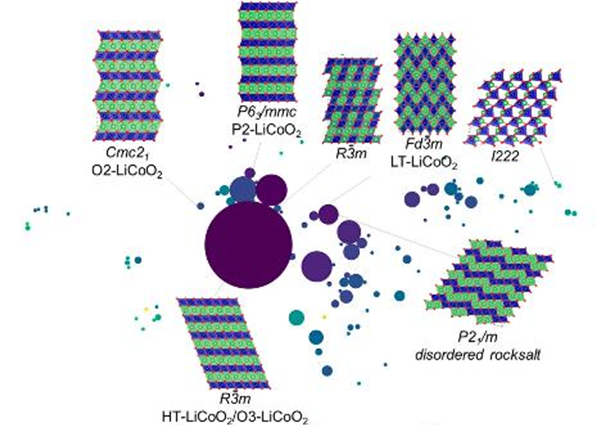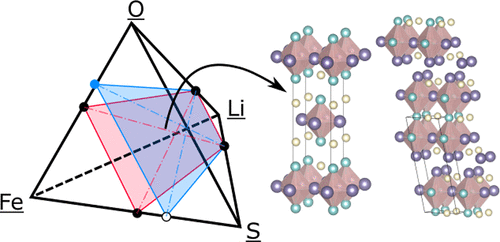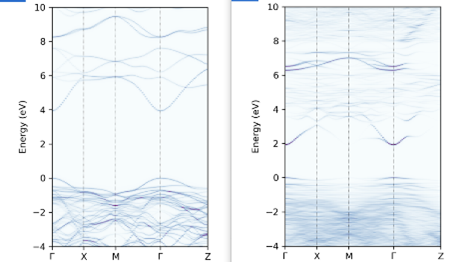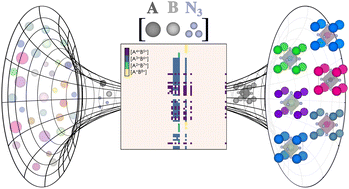Morden high-throughput calculations of materials properties can generate vast amount of data yet locating new and novel materials is no easy task. We aim to develop methods that can identify new materials using data, domain knowledge and direction exploration of the configuration space and apply them to industrial relevant fields such as energy, optoelectronic and semiconductor materials.
A recurring theme in our approach which set us apart from traditional high-throughput screening is the extensive usage of crystal structure prediction (CSP) techniques, which allow us to access under-explored regions of the chemical space (where existing data are scarce) and also to further validate the global stability of proposed theoretical models.
Li-ion cathode materials
Cathode is the performance and cost critical component of Li-ion batteries. Discovering high-capacity and low-cost cathode materials is essential to expand the applications and help increasing the use of sustainable energy sources [1,2,3].
This project combines structure prediction and data-driven materials design to locate potential new cathode materials with earth abundant elements and high capacity.
Left: Reproducing experimental structure (and polymorphs) through ab initio random structure searching (AIRSS). Right: Searching for stable oxysulphides in the Li-Fe-S-O chemical space.
Optoelectronics
Optoelectronic materials have a wide range of applications in various fields such as display, lighting, and electronics.
We develop and optimize materials that have potential applications as next generation semiconductor devices and display technologies [4,5].
Left: Wide band gap semiconductor materials with tunable band gap through disordering. Right: High-throughput prediction of nitride perovskites and verifying their stability using AIRSS.
References
2024
-
Discovery of multi-anion antiperovskites X6NFSn2 (X = Ca, Sr) as promising thermoelectric materials by computational screening
Dan Han, Bonan Zhu, Zenghua Cai, and 6 more authors
Matter, Jan 2024
The thermoelectric performance of existing perovskites lags far behind that of state-of-the-art thermoelectric materials such as SnSe. Despite halide perovskites showing promising thermoelectric properties, namely, high Seebeck coefficients and ultralow thermal conductivities, their thermoelectric performance is significantly restricted by low electrical conductivities. Here, we explore new multi-anion antiperovskites X6NFSn2 (X = Ca, Sr, and Ba) via B-site anion mutation in antiperovskite and global structure searches and demonstrate their phase stability by first-principles calculations. Ca6NFSn2 and Sr6NFSn2 exhibit decent Seebeck coefficients and ultralow lattice thermal conductivities (\textless1 W m−1 K−1). Notably, Ca6NFSn2 and Sr6NFSn2 show remarkably larger electrical conductivities compared to the halide perovskite CsSnI3. The combined superior electrical and thermal properties of Ca6NFSn2 and Sr6NFSn2 lead to high thermoelectric figures of merit (ZTs) of ∼1.9 and ∼2.3 at high temperatures. Our exploration of multi-anion antiperovskites X6NFSn2 (X = Ca, Sr) realizes the “phonon-glass, electron-crystal” concept within the antiperovskite structure.
2023
-
Exploring battery cathode materials in the Li-Ni-O phase diagrams using structure prediction
Jiayi Cen, Bonan Zhu, and David O. Scanlon
Journal of Physics: Energy, Jun 2023
The Li-Ni-O phase diagram contains several electrochemically active ternary phases. Many compositions and structures in this phase space can easily be altered by (electro-)chemical processes, yielding many more (meta-)stable structures with interesting properties. In this study, we use ab initio random structure searching (AIRSS) to accelerate materials discovery of the Li-Ni-O phase space. We demonstrate that AIRSS can efficiently explore structures (e.g. LiNiO2) displaying dynamic Jahn-Teller effects. A thermodynamically stable Li2Ni2O3 phase which reduces the thermodynamic stability window of LiNiO2 was discovered. AIRSS also encountered many dynamically stable structures close to the convex hull. Therefore, we confirm the presence of metastable Li-Ni-O phases by revealing their structures and properties. This work will allow Li-Ni-O phases to be more easily identified in future experiments and help to combat the challenges in synthesizing Li-Ni-O phases.
-
Accessible chemical space for metal nitride perovskites
Bastien F. Grosso, Daniel W. Davies, Bonan Zhu, and 2 more authors
Chemical Science, Aug 2023
Building on the extensive exploration of metal oxide and metal halide perovskites, metal nitride perovskites represent a largely unexplored class of materials. We report a multi-tier computational screening of this chemical space. From a pool of 3660 ABN3 compositions covering I–VIII, II–VII, III–VI and IV–V oxidation state combinations, 279 are predicted to be chemically feasible. The ground-state structures of the 25 most promising candidate compositions were explored through enumeration over octahedral tilt systems and global optimisation. We predict 12 dynamically and thermodynamically stable nitride perovskite materials, including YMoN3, YWN3, ZrTaN3, and LaMoN3. These feature significant electric polarisation and low predicted switching electric field, showing similarities with metal oxide perovskites and making them attractive for ferroelectric memory devices.
2022
-
Predicting Lithium Iron Oxysulfides for Battery Cathodes
Bonan Zhu, and David O. Scanlon
ACS Applied Energy Materials, Jan 2022
Cathode materials that have high specific energies and low manufacturing costs are vital for the scaling up of lithium-ion batteries (LIBs) as energy storage solutions. Fe-based intercalation cathodes are highly attractive because of the low cost and the abundance of raw materials. However, existing Fe-based materials, such as LiFePO4, suffer from low capacity due to the large size of the polyanions. Turning to mixed anion systems can be a promising strategy to achieve higher specific capacity. Recently, antiperovskite-structured oxysulfide Li2FeSO has been synthesized and reported to be electrochemically active. In this work, we perform an extensive computational search for iron-based oxysulfides using ab initio random structure searching (AIRSS). By performing an unbiased sampling of the Li–Fe–S–O chemical space, several oxysulfide phases have been discovered, which are predicted to be less than 50 meV/atom from the convex hull and potentially accessible for synthesis. Among the predicted phases, two anti-Ruddlesden–Popper-structured materials Li2Fe2S2O and Li4Fe3S3O2 have been found to be attractive as they have high theoretical capacities with calculated average voltages of 2.9 and 2.5 V, respectively, and their distances to hull are less than 5 meV/atom. By performing nudged-elastic band calculations, we show that the Li-ion transport in these materials takes place by hopping between the nearest neighboring sites with low activation barriers between 0.3 and 0.5 eV. The richness of materials yet to be synthesized in the Li–Fe–S–O phase field illustrates the great opportunity in these mixed anion systems for energy storage applications and beyond.
2021
-
Accelerating cathode material discovery through ab initio random structure searching
Bonan Zhu, Ziheng Lu, Chris J. Pickard, and 1 more author
APL Materials, Dec 2021
The choice of cathode material in Li-ion batteries underpins their overall performance. Discovering new cathode materials is a slow process, and all major commercial cathode materials are still based on those identified in the 1990s. Discovery of materials using high-throughput calculations has attracted great research interest; however, reliance on databases of existing materials begs the question of whether these approaches are applicable for finding truly novel materials. In this work, we demonstrate that ab initio random structure searching (AIRSS), a first-principles structure prediction method that does not rely on any pre-existing data, can locate low energy structures of complex cathode materials efficiently based only on chemical composition. We use AIRSS to explore three Fe-containing polyanion compounds as low-cost cathodes. Using known quaternary LiFePO4 and quinary LiFeSO4F cathodes as examples, we easily reproduce the known polymorphs, in addition to predicting other, hitherto unknown, low energy polymorphs and even finding a new polymorph of LiFeSO4F that is more stable than the known ones. We then explore the phase space for Fe-containing fluoroxalates, predicting a range of redox-active phases that are yet to be experimentally synthesized, demonstrating the suitability of AIRSS as a tool for accelerating the discovery of novel cathode materials.



